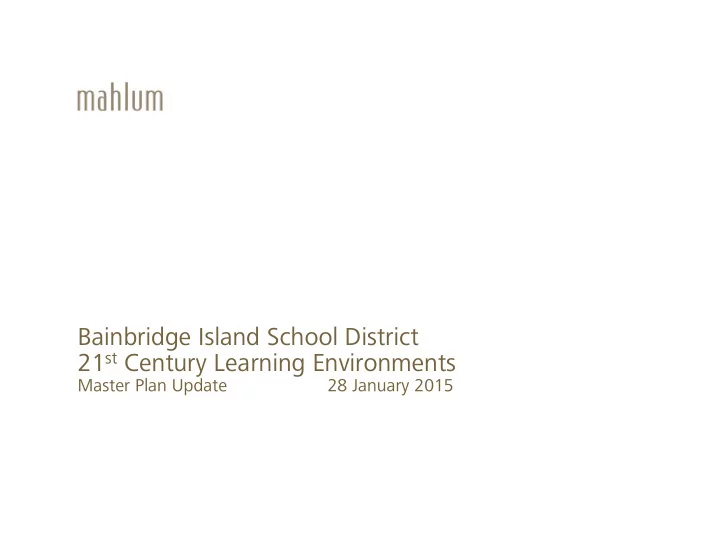

Bainbridge Island School District 21 st Century Learning Environments Master Plan Update 28 January 2015
Elements of the 21 st Century School
Bainbridge Island School District Our mission as a learning organization is to ensure that every student is future ready: :: Prepared for the global workplace :: Prepared for college :: Prepared for personal success
Bainbridge Island School District Our vision is committed to providing each student with an excellent academic program in an engaging and supportive environment that: :: Fosters a passion for learning :: Instills a sense of civic and social responsibility, and :: Develops the intellectual, physical, and social skills necessary for success in career, college, and life in the 21 st century
US Department of Education Guidelines Provide for health, safety, and Enhance teaching and learning security and accommodate the needs of all learners Make effective use of all adaptable resources Allow them to serve as centers of the community Allow for flexibility and adaptability to changing needs Result from a planning | design process involving all stakeholders
Elements of the 21 st Century School
Elements of the 21 st Century School :: Sharing Facilities and :: Multiple Use Spaces Leveraging Resources :: Learning Everywhere :: Adapt and Re-use Existing Facilities :: Design Patterns :: Expanding the Boundaries :: Partnerships Aligning services & programs :: Design Trends Creating new learning opportunities
Multiple Use Spaces
long-term adaptability
long-term adaptability
long-term adaptability departmental
long-term adaptability independent
long-term adaptability integrated
long-term adaptability project-based
long-term adaptability small schools
Learning Everywhere
Facilitate Learning Everywhere Corridors Collaboration Spaces Outdoor Spaces Connected Breakout Spaces Transparent Presentations Spaces – Scaled Large & Small
Facilitate Learning Everywhere Flexible | Adaptable | Convertible Engaging Durable | Enduring Safe Celebrates Culture Healthy Inspirational Challenging Courageous Supportive
Design Patterns
Learning Modalities – 21 st Century School :: Student presentations :: Independent study :: Performance & music-based :: Peer tutoring :: Seminar style instruction :: Team collaborative work :: Community service learning :: One-on-one with teacher :: Naturalist learning :: Lecture format :: Social | emotional learning :: Project-based learning :: Art-based learning :: Technology-based learning :: Storytelling (floor seating) :: Distance learning :: Learning by building :: Research via Internet
Partnerships
Seek Education Partnerships & Joint Use Augment School Programs Provide Educational Opportunity Before and After School Potential Funding Source Shared Sites (Parks and Recreation & others)
Aligning Services & Programs Rosa Parks School, Portland, OR Dull Olson Weekes
Rosa Parks School, Portland, OR Dull Olson Weekes
Sharing Facilities and Leveraging Resources Truman Learning Center, Federal Way, WA Mahlum
Truman Learning Center, Federal Way, WA Mahlum
Truman Learning Center, Federal Way, WA Mahlum
Truman Learning Center, Federal Way, WA Mahlum
Truman Learning Center, Federal Way, WA Mahlum
Adapt and Re-use Existing Facilities
Adapt and Re-use Existing Buildings Keeps School Facilities in Additions and Renovations Established Neighborhoods to Existing Buildings Adaptive Reuse of Other Building Types into Schools: Warehouses, Office buildings, Retail
Expanding the Boundaries
Integrate Technology Throughout Visual Literacy Not Only about Computer Literacy Storytelling Collaboration
Integrate Technology Throughout Disrupting Class, How Disruptive Rethinking Education Innovation Will Change the Way in the Age of Technology the World Learns Allan Collins and Clayton M. Christensen Richard Halverson with Michael B. Horn and Curtis W. Johnson
Utilize Neighborhood & World as Campus Expand Learning by Creating Utilize Skype and Other Social, Collaborative and Technology to Foster Meaningful Connections that Connections Locally & are Relevant and Empowering Internationally Utilize Neighborhood Venues for Drama | Music Presentations
Maximize Site Connection to Community Reduces the Need for Large Site Utilize Parks & Recreation Centers and Sites, Potentially Freeing Up School District Land for More Outdoor Learning Opportunities
The School Without Walls, Washington, DC
Environmental Responsibility
Embrace Sustainable Design Create Building as a Teacher of Teachers and Students Environmental Stewardship & a Perform Best when Building Laboratory for Learning About Performs Well: Natural Processes Comfortable Environment Free of Irritants | Toxins Increase User Performance Minimize Energy & Resource Use
Sustainable School Opportunities Envision a sustainable school Establish sustainability goals Identify opportunities and strategies Identify educational opportunities
Environmental Impact of Buildings 65.2% of total 136 million tons U.S. electricity consumption of construction and demolition waste in the U.S. 36% of total (approx. 2.8 lbs/person/day) U.S. primary energy use 12% of potable water 30% of total in the U.S. U.S. greenhouse gas emissions 40% (3 billion tons annually) of raw materials use globally
Benefits of High Performance Design Environmental benefits Health and safety benefits Reduce the impacts of natural Enhance occupant comfort resource consumption and health Economic benefits Educational benefits Reduce operating costs Improve quality of educational experience
Benefits of High Performance Design Increase student performance Indoor air quality NCEF Healthier, more comfortable www.edfacilities.org environments/reduced absenteeism Daylighting Heschong Mahone study Acoustics Quality of daylight / Good acoustics/good academic improvement in learning performance
Bainbridge Island School District 21 st Century Learning Environments Master Plan Update 28 January 2015
Recommend
More recommend